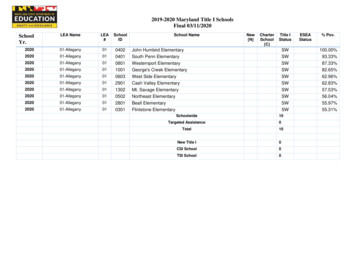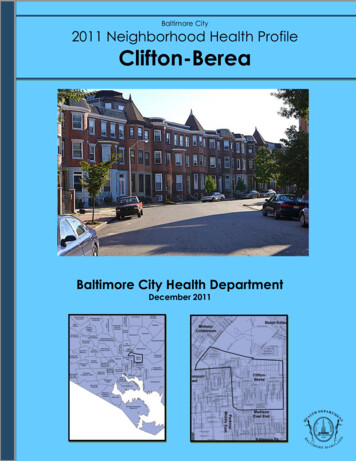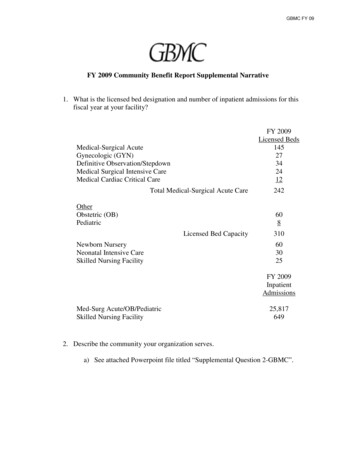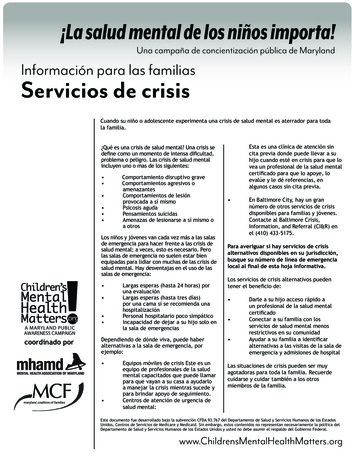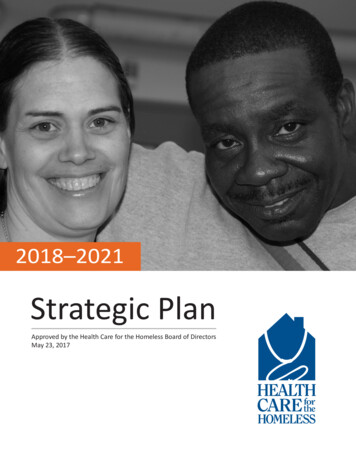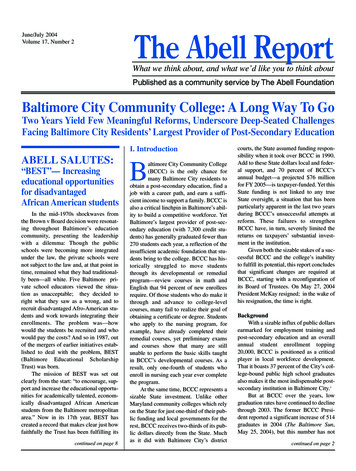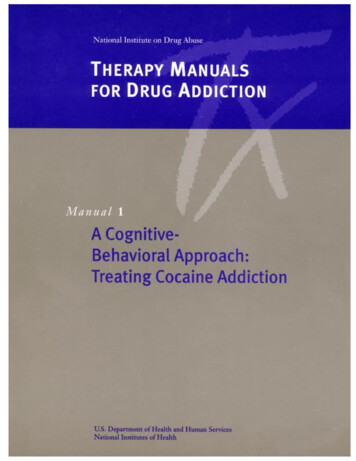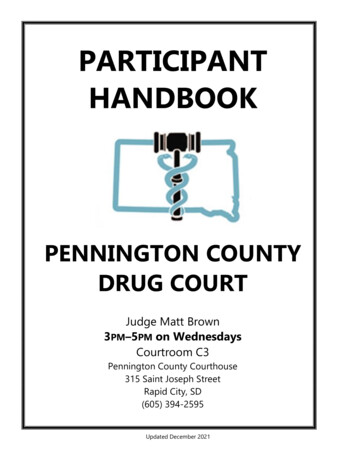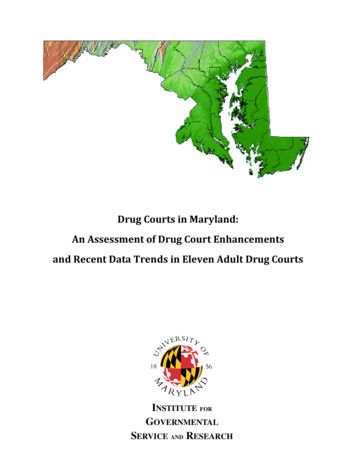
Transcription
Drug Courts in Maryland:An Assessment of Drug Court Enhancementsand Recent Data Trends in Eleven Adult Drug CourtsINSTITUTE FORGOVERNMENTALSERVICE AND RESEARCH
ii
Drug Courts in Maryland:An Assessment of Drug Court Enhancementsand Recent Data Trends in Eleven Adult Drug CourtsPrepared by:Douglas W. YoungElizabeth M. GrantAmy N. HoInstitute for Governmental Service and ResearchUniversity of Maryland4321 Hartwick Road, Suite 208College Park, Maryland 20742September 30, 2015
AcknowledgementsThis project was supported by Grant No. 2011-DC-BX-0132 awarded by the Bureau of JusticeAssistance. The Bureau of Justice Assistance is a component of the Office of Justice Programs, which alsoincludes the Bureau of Justice Statistics, the National Institute of Justice, the Office of Juvenile Justiceand Delinquency Prevention, the Office for Victims of Crime, the Community Capacity DevelopmentOffice, and the Office of Sex Offender Sentencing, Monitoring, Apprehending, Registering, and Tracking.Points of view or opinions in this document are those of the author and do not necessarily represent theofficial position or policies of the U.S. Department of Justice.We wish to acknowledge the drug court coordinators, judges, and other team members whowelcomed us to their courtrooms and offices, and kindly contributed information and invaluable insightsto this effort. We are grateful to Gray Barton, Director of the Maryland Office of Problem Solving Courts,for his enthusiastic support for this research and for his persistent yet always congenial efforts toimprove the effectiveness of drug courts and other specialized courts in the state. Thanks go also tocolleagues present and past at IGSR who assisted in this work, including Benjamin Falls, Jeanne Bilanin,Emily Glazener, Sharon Gibbs Cooper, Janet Romsaas, Leeza Shapiro, Matt Schatz, and Maggie Hsu.iv
Table of ContentsAcknowledgements. ivIntroduction . 1Methodology. 1Report Organization . 3Enhancement Courts. 4Baltimore City Drug Treatment Court—Circuit Court . 4Court History . 4Court Structure . 5Court Operations. 11Substance Abuse Treatment and Other Services . 16Participant Characteristics . 19Drug Court Enhancements under BJA Funding . 22Data Trends during the Enhancement Period. 25NADCP Best Practices Standards . 35Summary of Recommendations. 42Carroll County Circuit Adult Drug Treatment Court. 44Court History . 44Court Structure . 44Court Operations. 47Substance Abuse Treatment and Other Services . 52Participant Characteristics . 54Drug Court Enhancements under BJA Funding . 55Data Trends during the Enhancement Period. 59NADCP Best Practices Standards . 65Cecil County Adult Drug Court . 70Court History . 70v
Court Structure . 70Court Operations. 74Substance Abuse Treatment and Other Services . 79Participant Characteristics . 81Drug Court Enhancements under BJA Funding . 82Data Trends during the Enhancement Period. 85NADCP Best Practices Standards . 91Wicomico County Adult Drug Treatment Court. 97Court History . 97Court Structure . 97Court Operations. 102Substance Abuse Treatment and Other Services . 109Participant Characteristics . 111Drug Court Enhancements under BJA Funding . 112Data Trends during the Enhancement Period. 114NADCP Best Practices Standards . 119Other Adult Drug Courts . 125Anne Arundel County Circuit Drug Court . 125Admissions, Discharges, and Active Participants, 2014 Calendar Year . 125Trends in Participant Admissions, Census, and Discharges . 126Service Referrals, Sanctions, and Incentives . 128Anne Arundel County District Drug Court. 131Admissions, Discharges, and Active Participants, 2014 Calendar Year . 131Trends in Participant Admissions, Census, and Discharges . 132Service Referrals, Sanctions, and Incentives . 135Baltimore City District Drug Court . 138Admissions, Discharges, and Active Participants, 2014 Calendar Year . 138Trends in Participant Admissions, Census, and Discharges . 139Service Referrals, Sanctions, and Incentives . 142vi
Dorchester County District Drug Court . 145Admissions, Discharges, and Active Participants, 2014 Calendar Year . 145Trends in Participant Admissions, Census, and Discharges . 146Service Referrals, Sanctions, and Incentives . 148Montgomery County Circuit Drug Court . 151Admissions, Discharges, and Active Participants, 2014 Calendar Year . 151Trends in Participant Admissions, Census, and Discharges . 152Service Referrals, Sanctions, and Incentives . 155St. Mary’s County Circuit Drug Court . 158Admissions, Discharges, and Active Participants, 2014 Calendar Year . 158Trends in Participant Admissions, Census, and Discharges . 159Service Referrals, Sanctions, and Incentives . 162Worcester County Circuit Drug Court . 164Admissions, Discharges, and Active Participants, 2014 Calendar Year . 164Trends in Participant Admissions, Census, and Discharges . 165Service Referrals, Sanctions, and Incentives . 168Comparisons among Courts . 171Active Participants, Admissions, and Participant Characteristics . 171Active Participants . 171Admissions . 171Participant Characteristics . 172Discharges . 177Completion Rates . 177Service Referrals, Sanctions, and Incentives. 179Service Referrals . 179Sanctions and Incentives. 180Appendix: Data Tables . 184Admissions and Discharges . 184Admissions . 184vii
Discharges . 184Participant Characteristics . 185Program Census and Service Referrals . 186Program Census . 186Service Referrals . 186Sanctions . 187Incentives . 188viii
IntroductionApproaching the 25-year anniversary of the opening of the first drug treatment court in MiamiDade County, drug courts continue to grow and gain attention as jurisdictions nationally look to reversethe incarceration binge of prior decades. Maryland was one of the first states to make a commitment todrug courts, and today the state Office of Problem Solving Courts (OPSC) oversees one of the mostextensive networks of specialized courts in the country, including both circuit and district-court baseddrug court programs in the major metropolitan areas and smaller programs in rural counties in everyregion of the state.With funding support from the federal Bureau of Justice Assistance (BJA) and the MarylandJudiciary Administrative Office of the Courts, the Institute for Governmental Service and Research at theUniversity of Maryland, College Park undertook the study reported here of 11 of the state’s adult drugcourts. Employing methods detailed below, the research had three distinct components. The firstinvolved in-depth studies of four drug courts in Baltimore City and Carroll, Cecil, and Wicomico countiesthat had implemented program enhancements under BJA funding. In addition to a detailed descriptiveassessment of enhancement plans and progress in implementation, program data from the StatewideMaryland Automated Record Tracking (SMART) system were gathered and analyzed to further assessdrug court performance and outcomes at each site during the demonstration period. A second studycomponent involved analyzing similar data from SMART on seven additional drug court programs inBaltimore City and Anne Arundel, Dorchester, Worcester, St. Mary’s, and Montgomery counties. Thesesites were selected for inclusion by OPSC, and are representative of the diversity of drug courts in thestate. Using 3¼ years of data (January 2014 through March 2015), trends in admissions, activeparticipant census, and program completion results, along with common program elements (servicereferrals, participant sanctions, incentives) are assessed for each of these seven sites. Finally, acomparative analysis was done. Again drawing from the available SMART data, this narrativeassessment compares and contrasts recent data and trends among the 11 drug courts on the samedescriptive and performance measures listed above.MethodologyA mix of qualitative and quantitative methods was employed in studying the four drug courtsthat implemented program enhancements. Background information in the form of program and policymanuals provided by drug court coordinators at each site was reviewed and used as a basis of initialstructured telephone interviews done with each coordinator. Documents specific to the enhancementcomponents were also obtained and reviewed. These included narrative proposals for theenhancement funding and quarterly progress reports prepared and submitted to OPSC by each site forthe period from the effective beginning of the demonstration period (January 2012) through September2014. Following introductory phone interviews (and in some cases subsequent follow up via email), sitevisits were arranged and conducted at each drug court. These visits included an observation of drugcourt review hearings, typically over one of the court’s regularly scheduled half-day sessions, as well asinterviews with drug court team members. The structured interviews were tailored for the team roles in
each site, including the drug court judge, coordinator, case managers, Division of Parole and Probation(DPP) agents, public defenders, prosecutors, and substance abuse treatment staff. Interview protocolswere adapted as needed for specialized staff, including those incorporated as part of the proposedenhancements (e.g., a social worker in Baltimore City, peer recovery support counselors in CarrollCounty). Most interviews were conducted individually at the site; in a few cases, onsite interviews weredone with two team members performing the same role and some individual interviews were done afterthe site visit via telephone.For the study of the four enhancement sites, as well as the seven additional sites and thecomparative analysis, SMART data were obtained from pre-scripted automated program reports inseveral domains: admissions, discharges, case management activities, service referrals, sanctions, andincentives. Participant demographics and other characteristics were included as part of the admissionand discharge reports. The SMART data reports were exported to Excel and SPSS statistical software foranalysis purposes.The drug court sites (and treatment program partners) are responsible for all SMART data entryand the completeness (and reliability and validity) of these data. Through training and the persistentpersuasive efforts of OPSC there have been significant improvements in the amount and quality ofSMART data in recent years. Data on admissions, discharges (including program completion andtermination), and the active participant census and participant characteristics appear complete andreliable. Variations in the completeness of SMART data across courts (and across time within courts) doremain, however, and the amount of missing data from some courts in certain domains makes reportingand interpretation of these results dubious. Data on case management activities (planning and reviewmeetings with participants and team members) and treatment were thus excluded from analyses, andwhere noted, data on service referrals, and in a few cases sanctions and incentives, must be viewed withthis caveat in mind.For the enhancement site analysis, SMART data were obtained for quarterly periods beginningin 2011, the year prior to demonstration startup. Data were collected through the second quarter(April-June) of 2014, and the site visits and interviews were conducted over late summer and throughthe final months of 2014. These reports present annual admissions and census data for the 2013calendar year, and compare trends over the pre-enhancement year (beginning January 2011) throughJune 2014. Drafts of the enhancement site report were reviewed for accuracy and updating by each ofthe site coordinators in the spring of 2015, and drug court judges and the other team membersreviewed a final draft during the summer. SMART data on the seven additional drug court sites wereobtained in the spring of 2015 and cover the period January 2012 through the first quarter (JanuaryMarch) of 2015. For purposes of the final comparative analysis, updated data were obtained on the fourenhancement sites to match the tracking period used for the seven additional sites. The reportsincluded here on these programs have not been reviewed by drug court team staff at these sites.2
Report OrganizationThe three study components appear sequentially as sections in this report. The fourenhancement site reports comprise the first section. Each of these begins with a detailed description ofthe drug court program, including the court’s history, structure (team members and their agencies,target population, screening and intake), and operations (legal mechanisms, phases and progression,incentives and sanctions policies), and the drug court’s substance abuse treatment and other ancillaryservice linkages. Annual data for 2013 are presented on admissions, active participants and participantcharacteristics, and on discharges and completion status. The next section describes plans andimplementation progress of enhancements made under the BJA funding awards. This is followed by anarrative and graphical account of data trends just before and during the enhancement period. Eachreport closes with a review and assessment of the program in light of eleven drug court standards areasexplicated by the National Drug Court Institute of the National Association of Drug Court Professionals(NADCP).The second section of this document includes more abbreviated reports on the seven additionaldrug court sites. As noted above, these discuss data trends for a 3 ¼ year period through March 2015 inadmissions, participant census and characteristics, discharges and completion status, service referrals,sanctions, and incentives. The last section of the report presents comparative results on thesedescriptive and performance areas, identifying and discussing patterns in the data often relating to thestate’s diversity of drug court participant populations and site locations. The discussion is accompaniedby figures and charts; an appendix shows the comparative results in table format.3
Enhancement CourtsBaltimore City Drug Treatment Court—Circuit CourtCourt HistoryThe Baltimore City Drug Treatment Court—Circuit Court (BCDTC/CC) was implementedin 1994. Felony cases as well as misdemeanor cases which come to the court by “jury trialprayers” are administered by the Circuit Court. The District Court in Baltimore City alsooperates a separate drug treatment court that hears misdemeanor cases. Operationally, theCircuit Court DTC includes two tracks, A and B. Until recently, Track A was known as theBaltimore City Felony Drug Diversion Initiative (FDI), which was established in 2003 as adiversionary program from long term incarceration for non-violent offenders with extensivecriminal histories and serious substance abuse problem. Funded with a 1 million federal grant,the FDI court was aimed at reducing the backlogs and postponements between arrest,arraignment, and trial dates for those opting into the original drug court, which often delayedtheir admission into DTC for six months or more. In the FDI, discretion in managing drug courtcases was shifted from the State’s Attorney to the Drug Court judge. The FDI program namewas dropped in 2013 when its model of operation was adopted for both Tracks A and B. Underthe current protocol potential participants are screened and formally assessed by the initialdate in court (arraignment for felons and 21 days after a request for jury trial for misdemeanorcases). Currently, it is possible for BCDTC/CC participants to enter treatment within 24 hours ofarraignment, depending upon the availability of an appropriate treatment placement.The Honorable Ellen M. Heller and the Honorable Thomas J. S. Waxter, Jr., both retired,are presiding judges for the BCDTC/CC. The Drug Treatment Court Coordinator is Angela Lowry.The Honorable Sylvester B. Cox is the Judge in Charge of the DTC.Evolved from the former FDI docket, Track A was originally reserved for more seriousoffenses (as defined by Maryland Sentencing Guidelines) and more involved treatment issues(such as co-occurring disorders), while Track B was intended for cases with less serious chargesand treatment issues. Judge Heller was instrumental in the creation of FDI and continues topreside over Track A; she has been with the DTC since 2003. Judge Waxter presides over TrackB and has been with drug court since 2010.4
Prior record or severity of addiction is no longer used to assign participants to aparticular track and both tracks draw from the same pool of defendants. Participants are nowassigned tracks alternately when they plea into DTC and each track is allocated a comparablenumber of cases each month. Currently, Track A cases are heard on three Thursdays per month,while Track B cases are heard on Monday and Tuesday mornings.Court StructureCurrent Census and CapacityAs of April 30, 2014, the SMART database showed there were 474 active participants inthe DTC. Although the program does not have a stated target capacity, this represents adecrease over a program census that topped 600 during all of 2011. The drop in participants,described in more detail below, is attributable to various factors, some of which weretemporary. Technical problems with a new referral system instituted by the State’s Attorney’sOffice (SAO) in April 2014 precluded identification of a number of potential candidates. Then inMay 2014, medical leave of the State’s Attorney assigned to DTC precipitated a series ofsubstitutes who had varying expertise in the SAO process for identifying potential DTC cases.The falling numbers also reflect efforts made over 2012 and 2013 by the Coordinator and CaseManagers to update and improve the accuracy of the SMART database by removing cases from“active” status for individuals who had never been admitted to the program (cases for whichadmissions data were entered but elected not to participate), or had long been terminated orotherwise discharged from the program.A more persistent issue identified by the DTC team is that there are fewer cases beingreferred to the drug court, or electing or seeking to participate, which satisfy legal eligibilitycriteria for the program. Discussed further in the drug court standards section at the close ofthis report, Judge Heller and the Coordinator have indicated that adjustments to the eligibilitycriteria are being considered that would permit more defendants access to DTC while stillensuring public safety.OversightIn addition to oversight provided at the State level by the Drug Court OversightCommittee, administration and direction of the CC DTC is accomplished through theAdministrative Judge, the Judge in Charge of the Criminal Docket and a Drug Court AdvisoryCommittee.5
The Advisory Committee meets quarterly. Members include key DTC team membersand supervisors from member agencies: DTC judgesThe DTC CoordinatorThe DTC Care CoordinatorThe DTC Case ManagersThe DTC Social WorkerRepresentative of the State’s Attorney’s Office (SAO)Representative of the Office of the Public Defender (OPD)Representatives of the Division of Parole and Probation (DPP)Representative of Behavioral Health Services Baltimore (BHSB)The Judge in Charge of Drug Court chairs the Advisory Committee and is also responsible foroversight of the DTC.The DTC Coordinator is supervised by the DTC judges and reports to them regularly. Shealso reports quarterly to the Advisory Committee and is responsible for administering recordsrelated to the drug court.Drug Treatment Court TeamEach track of the Drug Treatment Court has a team comprised of these members: DTC Judge (3)o Judge Cox is the Judge in Charge.o Judge Heller presides over Track A/FDI and is the only judge to have presidedover Track A. She has presided over drug court since 2003.o Judge Waxter has presided over Track B cases since 2010. Prior to this date,several judges had rotated through this position. DTC Coordinatoro Angela Lowry is the DTC Coordinator for both tracks. She has served in thiscapacity for approximately four years.6
o The DTC Coordinator has daily operational oversight of the CC drug court. Sheoversees relations and coordination between the DTC and substance treatmentproviders and other community-based service entities. The Coordinatorsupervises Case Managers, the Social Worker, and the Care Coordinator assignedto Track B. Case Managers (2)o The current Case Managers (CM) joined the DTC team within the past two years(one hired in the summer of 2013 and the other in late spring of 2014). CaseManagers serve both tracks, and rotate on a monthly basis sitting in on cases ineach track.o Case Managers enter data in the Statewide Maryland Automated RecordTracking (SMART) system used by Maryland’s DTCs, and assist participants withall non-treatment needs such as job training/placement, housing, educationprograms, eligibility for benefits, and obtaining IDs and Social Security numbers. Office of the Public Defender (2)o Assistant Publi
Assistance. The Bureau of Justice Assistance is a component of the Office of Justice Programs, which also includes the Bureau of Justice Statistics, the National Institute of Justice, the Office of Juvenile Justice and Delinquency Prevention, the Office for Victims of Crime, the Community Capacity Development
